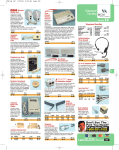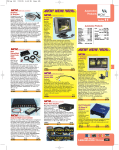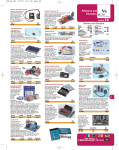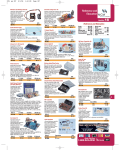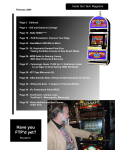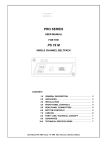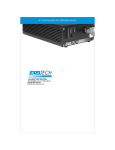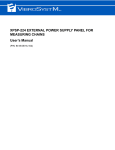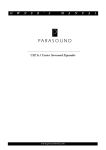Download Stellar Industries SLA250 User's Manual
Transcript
Two Channel Contractor Series Power Amplifiers SLA150 SLA250 SLA470 MODEL 75W RMS x Two Channels 125W RMS x Two Channels 235W RMS x Two Channels Distributed Exclusively by: Stellar Labs™ www.stellarlabs.com MCM Electronics www.mcminone.com Safety Information The lightning bolt within a triangle is intended to alert the user to the presence of un insulated dangerous voltage levels within the product’s enclosure. To reduce the risk of electric shock, do not remove cover of this device. There are no user serviceable parts inside. Refer servicing only to qualified service personnel. This voltage may be of sufficient magnitude to constitute an electric shock risk. Safety Precautions • • • • • • • • • • • • • 2 The exclamation point within a triangle is intended to alert the user to important operating and maintenance (servicing) instructions in the literature accompanying the appliance. Read and retain these instructions Follow all instructions and heed warnings Do not use this device near water If the surface becomes dirty, clean only with dry cloth, do not use solvents or thinners Install in accordance with the manufacturer’s instructions Do not block ventilation openings Do not install near heat sources such as radiators, heat registers, stoves, or other devices that produce heat Do not defeat the safety purpose of the grounded plug. This plug has two blades and a third ground prong. The wide blade or third prong are provided for your safety. If the provided plug does not fit into your outlet, consult an electrician for replacement of the obsolete outlet Protect the power cord from being stressed at the plugs, convenience receptacles, and where they exit the amplifier Only use accessories specified by the manufacturer Unplug the device during lightning storms or when unused for an extended time Refer all servicing to qualified personnel This device must not be exposed to water in any way. No object filled with liquids should be placed on apparatus Congratulations on your purchase of this Stellar Labs SLA Series Stereo Amplifier This amplifier was designed specifically for use in distributed audio installations, where high reliability and premium sound quality are a must. Remote on/off triggering and signal sensing allow these units to be set up in equipment racks, with no further contact required. Rear mounted master level controls keep installation safe from future tampering. Two auto–switching inputs allow automatic operation when used with more than one system. This amplifier is warranted from defects for one year from the date of purchase. Should your amplifier require service, either within or beyond that warranty period, please contact your MCM Sales Representative. This unit includes a host of features, along with an impressive list of specifications, which are detailed over the next pages. Please take the time to read this document completely prior to installation of this product. Should you have questions regarding installation or operation of this unit, please contact the MCM Technical Support Department. Features Two sets of L/R inputs, each may be switched to accept line level speaker level signal Auto– switching between inputs, with adjustable delay Line level pass through output on input #2 Manual or auto–sensing power control 12V trigger input allows power–on command from external components 12V trigger output allows amplifier to trigger external components Stereo and bridged mono operation Heavy–duty binding post speaker outputs Discrete output components Specifications (all models) THD: <0.2% (at 4ohm) Crosstalk: <65dB @ 1KHz Frequency Response: 20Hz ~ 20KHz +/- 0.5dB S/N Ratio: >100dB Model SLA150 50W RMS per channel, both channels driven into an 8ohm load 80W RMS per channel, both channels driven into a 4ohm load 150W RMS bridged mono, into an 8ohm load Power requirements: Selectable 115/230VAC, 60/50Hz, 450W max Dimensions: 3 1/2" (H) x 16 1/2" (W) x 14" (D) Weight: 21 lbs Model SLA250 80W RMS per channel, both channels driven into an 8ohm load 125W RMS per channel, both channels driven into a 4ohm load 250W RMS bridged mono, into an 8ohm load Power requirements: Selectable 115/230VAC, 60/50Hz, 700W max Dimensions: 3 1/2" (H) x 16 1/2" (W) x 14" (D) Weight: 26 lbs Model SLA470 150W RMS per channel, both channels driven into an 8ohm load 235W RMS per channel, both channels driven into a 4ohm load 470W RMS bridged mono, into an 8ohm load Power requirements: Selectable 115/230VAC, 60/50Hz, 1200W max Dimensions: 5 1/4" (H) x 16 1/2" (W) x 14" (D) Weight: 33 lbs 3 Front Panel Controls Power Provides manual on/off control of the amplifier. For this control to operate normally, the rear Trigger/Auto-On/Normal selector must be in the Normal position. If using the Trigger or Auto On mode, this switch must remain in the ON position. On/Standby Indicator Bi-color lamp provides immediate indication of the amplifier status. With the power switch OFF, the lamp is not lit. With the power switch ON, and Trigger or Auto-On in STANDBY mode, the lamp is red. When the amplifier is manually, automatically (signal sensing) or externally triggered ON, the lamp lights blue. This allows the user to immediately know the exact status of the amplifier from anywhere in the room. A/B Speaker Selector Each A and B pushbutton operates independently. Pressing the button in will engage the speaker pair for the designated output. Pressing again will disengage that output. With both pairs on, the speaker outputs are parallel. Balance This provides trim adjustment between the Left and Right audio channels of the amplifier. Note that this is a “trim” control, in that it provides for fine adjustment between the two channels. Unlike conventional “balance” controls on consumer audio equipment, this control will not completely mute the opposing channel, even when turned fully clockwise or counterclockwise. Volume This provides volume trim adjustment, simultaneously for the and right channels. Note that the master volume level is set via the recessed Master Level Controls on the rear panel. The front panel volume control is intended to provide fine up/down adjustment from the preset level. This is especially useful in distributed audio applications, as it allows the Installer to set the overall amplifier limit, while allowing the user only a limited range of adjustment. This greatly reduces the risk of speaker and component damage from abuse or tampering after the installation is complete. Caution Prior to connecting this unit to AC power, Note the following critical information Power Source Selection Locate this switch on the right side of the rear panel, directly next to the power cord connection. Make sure this switch is in the proper connection prior to connecting power. Failure to do so could result in permanent damage to the amplifier and potentially create a hazard, even if the amplifier is switched off. 4 Rear Panel Connections / Controls 1 2 3 4 5 6 7 L/R Line Input #1 L/R Line Input #2 L/R Input #2 Feed-through L/R Speaker Level Input Speaker Input Selector L/R Master Level Control Stereo / Bridged Selector #1) L/R Line Input #1 (priority) #2) L/R Line Input #2 (default) 8 9 10 11 12 13 14 12VDC Trigger Input 12VDC Trigger Output Power On/Off Mode Select Speaker Pair “A” Output Speaker Pair “B” Output IEC Power Line Cord Input 115/230VAC Power Selector Conventional line level input accepts signal from typical audio sources, such as tape or CD players, computer sound cards, MP3 and similar portable devices, television audio outputs or DVD players. If this amplifier is to be connected to an existing home theater system, to drive remote speakers, this input should be connected to the home theater’s TAPE, or PREAMP output. Conventional line level input accepts signal from typical audio sources, such as tape or CD players, computer sound cards, MP3 and similar portable devices, television audio outputs or DVD players. If this amplifier is to be connected to an existing home theater system, to drive remote speakers, this input should be connected to the home theater’s TAPE, or PREAMP output. The amplifier automatically defaults to this input upon power up, and will only be active when no signal is present at the Line #1 Input. As soon as a signal is detected at the Line #1 input, the amplifier will automatically switch to the Line #1 Input. If silence is detected at the Line #1 Input, it will switch back to the Line #2 Input. If a signal is present at both inputs, the Line #1 Input will take precedence over the Line #2 Input. The Delay Control will effect length of silence time required to pass prior to switching back to Input #2. This prevents unwanted switching during quiet passages between songs or in movie soundtracks. Ideal application of these two inputs is as follows: Use the SLA Amplifier to power several zones of speakers throughout the house. Connect the Tape output from the Home Theater system to the Line #2 Input. When the Theater System is powered on, the SLA Amplifier will also power on, sending the sound source throughout the home. A secondary source, such as a remote MP3 player connector, iPod™ docking station or similar, could be connected to the Line #1 Input. When the portable device is connected to this input, and powered on, the amplifier will switch to this input, and play throughout the home. 5 #3) L/R Input #2 Feed-through Output This output is provided as a convenience feed-through from the Line #2 Input. What ever source is connected to the Line #2 Input, will play through this line level output. This is ideal for daisy chaining multiple amplifiers to drive a large number of zones. This output is unaffected by the autoswitching of the SLA Amplifier, as it will always feed from the Line #2 Input. #4) Speaker Level Input This input is intended to accept a signal directly from the speaker output of another audio amplifier. This can be useful if the audio source feeding the SLA Amplifier has no line level output, such as a television, or older stereo system. This input is also useful if an existing whole house audio system is in place, and it is desired to connect additional zones away from the central system. Or, if a room is added to an existing system, that requires connection of a large, high powered pair of speakers, or a passive subwoofer. This Speaker Level Input can be directed to either Input #1 (priority) or Input #2 (default) by use of the selector switch directly above the input. #5) Speaker Input Selector #6) Master Amplifier Level Control Directs the Speaker Level Input to either #1 or #2. When in the #2 position, the speaker level input will be provided at line level at the #2 Feed-Through Output. These independent Left/Right controls act as the main volume control for this amplifier. These are located on the rear to allow the installation contractor to limit the maximum volume level of the system. The front panel volume control acts as a trim adjustment, relative to the position of these rear controls. #7) Stereo / Bridged–Mono Mode Selector This selector allows the amplifier to act as a stereo (two channel) amplifier, or a single channel mono amplifier, with the power of both channels added together. This is useful when using the amplifier to drive a passive subwoofer. When using the amplifier in bridged mode, be certain to: • Use speaker loads of 8ohm or higher. Speakers or combinations of speakers that yield less than 8ohms can damage the amplifier • Only connect to the “A” speaker output • Be certain to observe proper connections • Your signal source should be connected to both Left and Right input channels • Master level controls should be set at exactly the same level • Front panel balance control should be set at the mid position #8) 12V Trigger Input #9) 12V Trigger Output When the Power On/Off Mode Selector is in the Trigger position, the amplifier can be externally switched ON and OFF from this input. When supplied with 12VDC, the amplifier immediately switches on. When 12VDC is removed, the amplifier immediately switches off. This input is a twoconductor 3.5mm connector, positive tip polarity. It should be provided with a 12VDC signal only. This output provides 12VDC, 100mA to control external devices from the ON/OFF operation of this amplifier. When the amplifier is on, 12VDC is immediately present, and switches off immediately when the amplifier switches off. This follows whether the Auto-On, 12V Trigger Input or manual ON/OFF control are used to turn the amplifier on. This allows the amplifiers Auto-Power-On function to control external devices. This output is a two-conductor 3.5mm connector, positive tip polarity. Caution: Do not connect loads greater than 100mA to this output. 6 #10) Power On/Off Mode Select This selector determines how the amplifier will be switched on and off. Normal provides completely manual operation from the front panel Power switch. Auto-On senses the presence of an input signal at Input #1 or Input #2. Upon the detection of this signal, the amplifier turns on immediately. After approximately 10 minutes of no signal, the amplifier will switch off. This mode requires the front panel POWER button to remain in the ON position. Trigger allows external ON/OFF control of the amplifier, through the 12V Trigger Input, found immediately to the left of this selector. This input looks for a 12VDC signal from an external device to turn this amplifier on and off. This mode requires the front panel POWER button to remain in the ON position. #11) Speaker “A” Output This binding post set provides connections for speakers controlled by the “A” pushbutton on the front panel Speaker Selector. These binding posts accept banana plugs, spade lugs, or bare speaker wire up to 12AWG. Use extreme care when connecting bare speaker wire to ensure that small strands to not short between adjacent terminals. Left and right speakers should be connected as normal for stereo operation. For bridged mono operation, the two (RED) positive terminals only are used. See the notation on the back panel for proper connection. #12) Speaker “B” Output This binding post set provides connections for speakers controlled by the “B” pushbutton on the front panel Speaker Selector. These binding posts accept banana plugs, spade lugs, or bare speaker wire up to 12AWG. Use extreme care when connecting bare speaker wire to ensure that small strands to not short between adjacent terminals. Left and right speakers should be connected as normal for stereo operation. The “B” output is not to be used for bridged operation. #13) Line Cord Input / Fuse Holder This provides a standard IEC type AC power cord connection. This removable type cord is convenient in certain installation applications, as it allow the power cord to be routed into racks or cabinets at an early stage, with connection of the amplifier later. A 72” cord is included with each unit, exact replacements are available at MCM Electronics or a variety of electronic/electrical retailers. Fuse Holder Amplifiers are shipped with preinstalled fuses that are the appropriate size for 115VAC operation. If the amplifier is to be operated at 230VAC, the fuse should be replaced with the proper size. Fuses are In the event that that fuse blows, only replace with a fuse of the same type and amperage rating. MCM Electronics recommends Littelfuse 213 Series, miniature 5mm x 20mm Slo–Blo® replacement fuses. 115VAC 230VAC Operation Model # Operation SLA150 4A 2A SLA250 6.3A 3.15A SLA470 10A 5A #14) Voltage Input Selector This selector allows use of the amplifier virtually any place in the world. The default setting for use in North America is 115V (switch in the up position). However it is recommended to verify this prior to connecting power. Note that improper power selection can cause immediate and permanent damage to the amplifier, even if the main power switch is not turned on. 7







